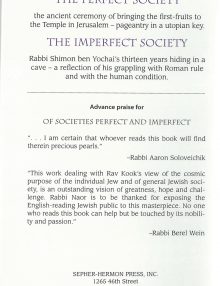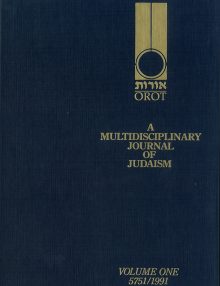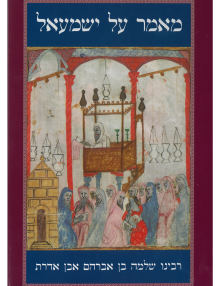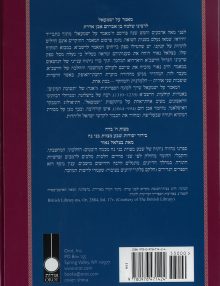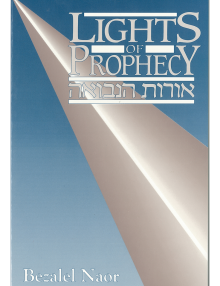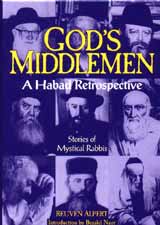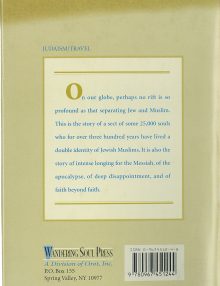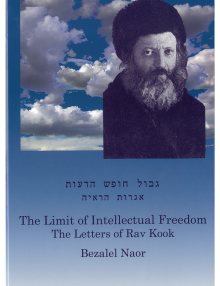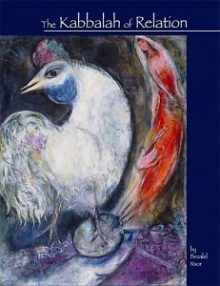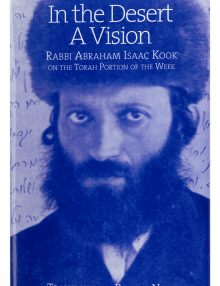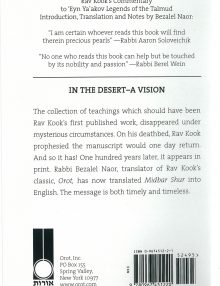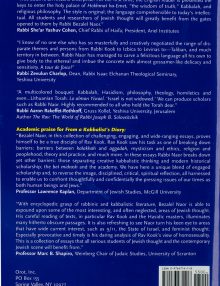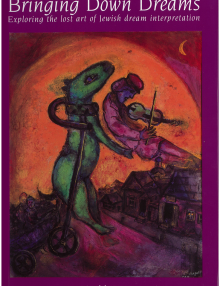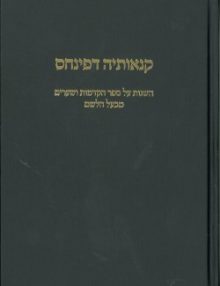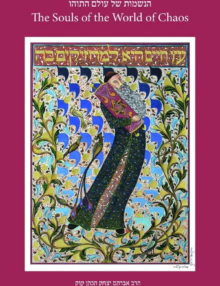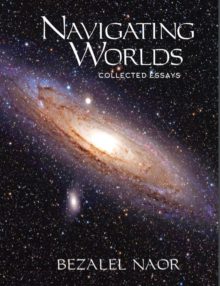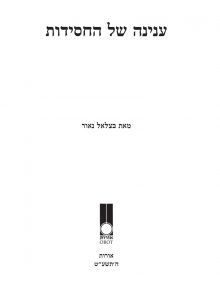- Home
- About Orot
About Orot
- Books
Books
- Articles
- Media
- Rav Kook
- Donate
- Contact Us
-
0$0.00
- No products in the cart.
-
0$0.00
- No products in the cart.
- Home
- About Orot
About Orot
- Books
Books
- Articles
- Media
- Rav Kook
- Donate
- Contact Us
Shop
Showing 17–29 of 29 results
-
Selected readings from Eyn Ayah, Rav Kook’s commentary to Eyn Yaakov Legends of the Talmud, (1995)
Introduction and Translation by Bezalel Naor 147 pp. Hardcover $17.50
The Perfect Society the ancient ceremony of bringing the first-fruits to the Temple in Jerusalem – pageantry in a utopian key.
The Imperfect Society Rabbi Shimon ben Yochai’s thirteen years hiding in a cave – a reflection of his grappling with Roman rule and with the human condition.
“This work dealing with Rav Kook’s view of the cosmic purpose of the individual Jew and of his general Jewish society, is an outstanding vision of greatness, hope and challenge. Rabbi Naor is to be thanked for exposing the English-reading Jewish public to this masterpiece. No one who reads this book can help but be touched by its nobility and passion.” —Rabbi Berel Wein“Whoever reads this book will find therein precious pearls”– Rabbi Aharon Soloveichik zt”l
Unavailable Out of Print
-
Bezalel Naor, “Rav Kook and Emmanuel Levinas on the “Non-Existence” of God, ” Richard Sugarman, “Questioning Levinas,” Asher Don Rabinowitz, “The Medical Aspects of Zara’at,” R. Shelomo Zalman of Kopyst, “The Curtains of the Tabernacle,” Eliyahu Zini, “A Rift in the Unity? / The Relation of Torah to the Sciences,” Shlomo Katz, “Rahav and Yehosua / Imagination and Intellect,” Shabtai Teicher, “On the Two Stages of Redemption,” Joshua Hoffman, “Rav Kook’s Mission to America,” Bezalel Naor, “Rav Kook’s Role in the Rebirth of Aggadah,” Rav A.Y. HaKohen Kook, “The Lion in the Cage” (Poem), Rivkah Hannah Beila Einhorn (Roberta Chester), “Isaac Luria” (Poem). 120 pp.
Unavailable Out of Print
-
Rabbi Solomon ben Abraham ibn Adret (1235-1310) was the Rabbi of Barcelona and the acknowledged spiritual leader of his generation. In this virtually unknown polemic work, he defends Judaism against the onslaught of Muslim theologian and critic Muhammad ibn Hazm (994-1064).
The text is based on a unique manuscript once housed in the Breslau Rabbinical Seminary. Researcher Bezalel Naor has relied on the transcription of one of the first graduates of the seminary, Joseph Perles, appended to Perles’ German monograph R. Salomo b. Abraham b. Adereth: Seine Leben und seine Schriften (Breslau, 1863). Naor’s lengthy introduction proves beyond a shadow of a doubt the attribution of the work to Rashba. In addition, the editor has included substantial footnotes and excursuses. The topic could not be more timely, as Judaism once again finds itself called upon to rise to the defense against the charges of Islamic triumphalists.
The volume includes a second original work by Bezalel Naor, Mitsvat Hashem Barah: An Elucidation of the Seven Noahide Commandments. The fascinating material is formatted both according to the order of Maimonides’ Hilkhot Melakhim and the order of the weekly Torah portion. (220 pp.)
Contained in the volume is a facsimile of a formal Haskamah (Approbation) from the late Talner Rebbe of Boston, Professor Isadore Twersy zt”l to Naor’s critical edition of Hassagot ha-Rabad le-Mishneh Torah (Jerusalem, 1984).
-
Unavailable Out of Print
(Bilingual) 1990
Selected readings on Prophecy/Nevuah Introduction and Translation by Bezalel Naor 83 pp. (56 pp. English+ 27 pp. Hebrew) -
1998) by Reuven Alpert
Introduction by Bezalel Naor
A good introduction to the world of Habad hasidism. Bezalel Naor’s introduction traces the history and intellectual development of hasidism. Reuven Alpert’s stories provide a glimpse of great Lubavitcher rebbes and hasidim. For those interested in Rav Kook, the book explains both his biological and spiritual kinship to this mystical movement known as the HaBaD (Hokhmah, Binah, Da’at) or Wisdom, Understanding, Knowledge School of Hasidism. 190 pp. (50 pp. introduction)OUT OF STOCK
-
In 1666, the mystic Shabbetai Zevi of Izmir (Smyrna) convinced most of the Jewish world that he was the righteous Messiah come to redeem his people Israel. Much of the Christian world, particularly Protestants in Western Europe, were equally fascinated by the tidings from the East (though they might have cast Shabetai Zevi in the role of Antichrist). All this came to a dramatic end with the Messiah’s forced conversion to Islam by the Sultan in Edirne (Adrianople). Was this truly the end? Does a Messiah ever truly end?
Reuven Alpert has doggedly tracked the remnants of Shabbetai Zevi’s followers in Greece and Turkey. A highlight of his journey is a visit to the home of this controversial personality in Izmir. Caught in the Crack is a search for the Messiah in time and space. Beyond that, Caught in the Crack has some disturbing things to say concerning Messiahs—Bar Kochba, Shabbetai Zevi, Jacob Frank—and the entire phenomenon of Messianism.
Reuven Alpert describes himself as a “spiritual anthropologist.” He has devoted several years to exploring exotic Jewish communities around the globe. He studied Talmudic law and Jewish philosophy in yeshivot and universities in the United States and Israel. His travelogs have appeared in Lifestyles magazine and elsewhere. Most recently, Mr. Alpert authored God’s Middlemen: A Habad Retrospective (White Cloud Press, 1998).
“On our globe, perhaps no rift is so profound as that separating Jew and Muslim. This is the story of a sect of some 25.000 souls who for over three hundred years have lived a double identity of Jewish Muslims. It is also the story of intense longing for the Messiah, of the apocalypse, of deep disappointment, and of faith beyond faith.” -
Unavailable & Out-Of-Print
-
Abraham Isaac Hakohen Kook served as the first Ashkenazic Chief Rabbi of Erets Israel from 1921 until his death in 1935. Born in Grieva, Latvia in 1865, he studied in the famed Volozhin Yeshivah, dubbed “the mother of yeshivot.” Beside the intellectual tradition of Volozhin, reaching back to the Vilna Gaon, Rav Kook was exposed in early childhood through his mother’s family to the mystical legacy of Habad Hasidism.
-
A startling new genre of Jewish book!
The Kabbalah of Relation
Kabbalah and Hasidism juxtaposed to the surrealist art of Marc Chagall.
Working with the model of the medieval bestiary, noted thinker Bezalel Naor explores the depths of human relation by way of a tour de force of Talmudic, Medieval Philosophic, Kabbalistic and Hasidic literature.
The Kabbalah of Relation juxtaposes images of surrealist painter Marc Chagall to ancient kabbalistic texts. Thereby, the texts and images bounce off one another. The images illuminate the texts (quite traditional for medieval manuscripts) and vice versa: the texts illuminate the images! So simultaneously, one has an artistic commentary to the Kabbalah, and a kabbalistic commentary to Chagall’s Surrealist Art.
-
In the Desert–a Vision (Midbar Shur) is Rav Kook’s own record of his derashot or talks over a span of two years, 1894-1896. This book, which should have been the author’s literary debut, is the last of his works to appear in print. The reason for the delay, is that the manuscript disappeared in mysterious circumstances. The book may have arrived a century late; its message is uncannily timely. Beside their visionary quality, Rabbi Kook’s talks are remarkable for their encyclopedic knowledge. A typical derasha will start with a verse in the Torah or passage in the Midrash. From there, Rabbi Kook will weave a rich tapestry encompassing the breadth of Jewish literature: Bible, Talmud, philosophy, and Kabbalah.
183 pp. -
The discipline of Kabbalah is generally subdivided into kabbalah ma’asit, practical or applied kabbalah, and kabbalah ‘iyyunit, theoretical kabbalah. In the popular imagination, the kabbalist is a practitioner of the magical arts. However, there is another sort of kabbalist whose way of relating to and interpreting the world is based on a profound system of thought.
Such a comprehensive, all-encompassing thought evidences itself in the spiritual diaries of Rabbi Abraham Isaac Hakohen Kook (1865-1935). Gershom Scholem, Professor of Jewish Mysticism at Hebrew University, Jerusalem, wrote: “Rabbi Kook’s great work… is a veritable theologia mystica of Judaism equally distinguished by its originality and the richness of its author’s mind. It is the last example of productive kabbalistic thought of which I know.” -
Bringing Down Dreams
Exploring the Lost Art of Jewish Dream Interpretation
-
Joseph
-
Daniel
-
Rabbi Hayyim of Volozhin
-
Rabbi Abraham Isaac Kook
-
Rabbi Hayyim Beliach
-
Rabbi Elijah Eliezer Dessler
What do all these men have in common? Each participated in an ongoing dialogue concerning the validity of dreams. This book offers the reader rare sources such as Rabbi Hayyim Beliach’s essay Petiha le-Mar’ot ha-Nevu’ah (Introduction to Prophetic Visions). It also makes available for the first time in English translation Rav Kook’s commentary to Perek ha-Ro’eh (The Chapter of the Seer). Finally, familiar Bible stories are given a fresh appraisal. All in all, a valuable contribution to the perennial wisdom of dream analysis.
-
-
RABBI PINHAS HAKOHEN LINTOP (1852-1924)
Pinhas Hakohen Lintop, Rabbi of the Habad community of Birzh, Lithuania, was an intimate friend and colleague of Rabbi Abraham Isaac Hakohen Kook. Their friendship began when Rabbi Kook served as Rabbi of Zoimel, Lithuania and later Boisk, Latvia, and continued even after Rav Kook immigrated to Erets Israel.
Showing 17–29 of 29 results


